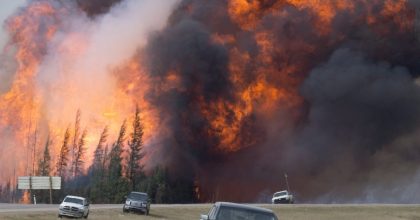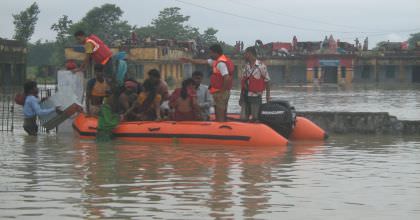


2016 Wildfire Season
According to the US National Academy of Sciences, over the past 30 years, there has been a fourfold increase in the number of large and long-duration forest fires in the American West. The length of the fire season has expanded by 2.5 months, and the size of wildfires has increased several times over. More than half the US Western states have experienced their largest wildfire on record since 2000.

Fort McMurray Fire
Alberta declared a state of emergency and ordered the evacuation of the more than 88,000 residents of Fort McMurray, a town in the heart of Alberta’s oil country, as a first responders struggle to contain a massive, wind-whipped wildfire.

Historic Houston Floods Bear Classic Climate Signature
The record-breaking rainfall driving Houston’s deadly floods parallels the trend toward more extreme rainfall in our warming world.

South Central Mayan Express Floods
A “remarkably rare” storm of “unprecedented strength” dumped record amounts of rain in the south central US beginning Monday, March 7, and forecasters expect the deluge to continue through Saturday. Northern Louisiana has seen the worst impacts so far, with widespread 1-in-200 year rainfall with locations experiencing 1-in-1,000 year rains.

Snowmageddon Redux
Six years after the Snowmageddon of 2010 buried the Washington DC area in up to 30 inches of snow, another major winter storm is poised to unload upwards of 30 inches of snow in the US capital, while threatening the Atlantic seaboard with hurricane-level storm surge.
Climate change is fueling the destructive power of this storm. Global warming increases ocean heat content, which increases the energy and moisture available to storms. It also increases the heat in the atmosphere, allowing the air to hold and dump more precipitation, and it causes sea level rise, which allows storm surge to ride on higher seas.

Climate change and El Niño fueled 2015’s record heat
2015 is the second of two back-to-back record hot years, and scientists say the record heat’s primary cause is climate change. During 2015, the average temperature across global land and ocean surfaces was 1.62°F (0.90°C) above the 20th century average. This was the highest among all years in the 1880-2015 record, surpassing the previous record set in 2014 by 0.29°F (0.16°C). This is also the largest margin by which the annual global temperature record has been broken.

Record rains ravage Chennai
India’s increase in extreme precipitation events in recent decades is likely tied to climate change. Following Southern India’s wettest November in more than 20 years, December 2015 began with a new round of extreme precipitation that inundated the city of Chennai. While November and December are typically very wet, the rainfall and flooding of 2015 were exceptional.

Yemen’s first cyclone on record fueled by record-warm sea-surface temperatures
Cyclone Chapala—a rare Middle Eastern cyclone—is poised to make landfall in Yemen as a Category 1 or 2 storm early Tuesday morning. It brings a dangerous storm surge, torrential rain, flooding and mudslides to Mukalla, a coastal city of 300,000 …

Strongest Hurricane Ever Nears Mexico Amid Record Season
Due to the combined impact of climate change and El Niño, 2015 has been a record year for tropical cyclones. Hurricane Patricia—the dangerous Category 5 storm currently bearing down on Mexico’s Pacific coast—will smash yet another record as the most intense hurricane ever recorded.

